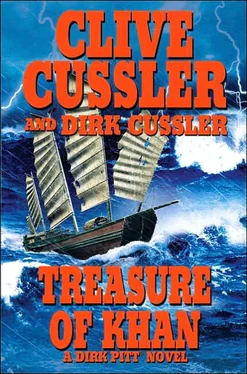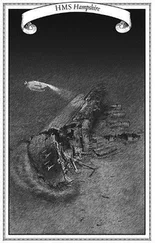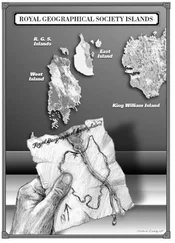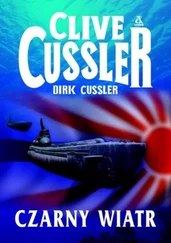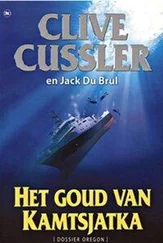Max frowned briefly as she rifled through her databases, then nodded at McCammon.
"You are absolutely correct, Doctor. The primary seismic waves were much smaller in magnitude than the surface waves for both quakes."
"Anything else, Max?" McCammon asked, finally finding a comfort level with the image.
"Yes, one final aspect. In both earthquakes, there was a record of low-magnitude P-waves registering before the actual quake-induced waves occurred."
"Foreshocks, I suppose," McCammon said. "Not at all unusual."
"Will somebody kindly explain all this surface wave and P-wave business?" Yaeger asked tiredly.
Max shook her head. "Must I teach you everything? Elementary seismology. The slippage from a common tectonic earthquake generates three types of seismic energy releases, or shock waves, if you will. The initial wave is called the primary, or P-type wave. It has similar properties to a sound wave, able to travel through solid rock and even the earth's core. A slower and hence secondary wave is called an S-wave. The S-waves are capable of shearing rock sideways to the direction of travel and produce the damaging vertical and horizontal movement of the ground when they reach the earth's surface. As both types of waves approach the surface, they refract to produce additional surface waves, which create the bulk of the shaking that is felt on the ground."
"I see," said Yaeger. "So they are essentially different frequencies sent out from an earthquake's epicenter."
"That's right," McCammon said.
"Is there a large fault line in the area where the two earthquakes struck?"
"The Persian Gulf actually lies near the boundary of two tectonic plates, called the Arabian and Eurasian.
Nearly all the seismic activity that takes place around the world is in narrow zones surrounding the plate boundaries. The large earthquakes we've seen historically in Iran, Afghanistan, and Pakistan would suggest that these two quakes in the gulf were not extraordinary but for their proximity."
"I guess your friend at Langley won't have too much to chew on," Yaeger said.
"I can't imagine," McCammon replied. "But thanks to Max, he'll have plenty of data to peruse."
As McCammon walked to the printer to retrieve the output, Yaeger threw one more question at the computer.
"Max, when you ran Phil's filter program did you match any other earthquakes to the same parameters?"
"Why, yes. It would be easier for me to show you graphically, so feast your eyes on the video board."
A large white screen behind Max was suddenly illuminated with a color map of the world. Two flashing red dots appeared in the Persian Gulf, marking the recent earthquakes. A few seconds later, a flurry of red dots erupted in several clusters, concentrated in an area of Northeast Asia. They were followed by a lone flashing dot slightly north of the others. McCammon set down his reports and approached the map in curiosity.
"A total of thirty-four seismic events were identified from the National Earthquake Information Center's data as matching the characteristics of the two sample earthquakes. The most recent occurred just over a week ago in Siberia," Max said, pointing to the lone red dot.
Yaeger's bleary eyes widened in shock. "And the locations of the other events?" he asked.
"Primarily Mongolia. Fifteen events occurred in the mountains east of the capital of Ulaanbaatar, ten in the southern Mongolian province of Dornogov, and another nine in an area just across the border in China. There was also one event in Siberia, at Lake Baikal."
"Mongolia," Yaeger muttered, shaking his head in disbelief. Slowly rising to his feet and rubbing his tired eyes, he turned to McCammon.
"Phil," he said, "I think you, me, and Max are going to need some coffee."
Listening to the latest Nils Lofgren CD on a portable MP3, Summer hummed along happily as she monitored the tension on the air lines snaking over the side of the barge. Boredom was just beginning to set in, and she found herself looking forward to getting back into the water and working the other end of the line. Standing up and stretching, she gazed seaward and caught sight of the black ship she had noticed earlier, now rounding Kahakahakea Point. Something nagged at the back of her brain as she watched the ship turn and aim its bow directly at the NUMA work barge.
"Please, no more media hounds," she said aloud, hoping it was not another boatload of reporters. But her deepening suspicions rang louder, and, as she studied the ship, she realized what it was.
The approaching vessel was a drill ship. Small by most drilling standards at less than two hundred fifty feet, the ship was at least thirty years old and had clearly seen better days. Rust appeared to grow from the ship's scuppers, while its deck and forecastle were stained with dirt and grease. It was less the appearance than the function of the ship that troubled Summer. What was a drill ship doing in Hawaiian waters? There were no oil deposits in the Hawaiian Islands to speak of, and the surrounding ocean depths quickly drop to over ten thousand feet, making any offshore drilling efforts a costly proposition.
Summer watched as the old ship continued churning directly for her, frothy sprays of white foam creasing away from its weathered bow. The ship was less than a mile away now and showed no signs of decreasing speed. When it closed to within a quarter mile still at speed, Summer glanced at a makeshift flagpole erected over the barge's sleeping shack. A large red diver's flag with the cautionary white slash across the middle fluttered in the morning breeze.
"I've got divers in the water, you idiot," she cursed as the ship continued its beeline track. The vessel was close enough that Summer could make out a couple of figures standing on the ship's bridge. She quickly walked to the facing rail then turned and waved an arm at the dive flag. Summer detected the ship finally starting to slow, but it was approaching without caution. It was clear by now that the drill ship intended to moor alongside the barge.
Summer hustled to the shack, where a marine radio was mounted to the wall. Spinning the dial on the VHF set to channel 16, she spat into the microphone.
"Approaching drill ship, this is NUMA research barge. We have divers in the water. I repeat, we have divers in the water. Please stand off, over."
She waited impatiently for a reply but there was none. With a greater urgency in her voice, she repeated the call. Again, there was no answer.
By now, the drill ship was only a few yards away. Summer returned to the rail and yelled at the ship while pointing to the dive flag. The ship started to turn, but, by its angle, Summer could see it was only preparing to pull alongside. Half expecting to see a horde of seasick reporters and cameramen lining the rail, she was surprised to find the ship's starboard and stern decks empty. A slight chill ran up her spine at seeing no one on deck, the men in the forecastle remaining concealed on the bridge.
With an experienced helmsman's touch, the drill ship glided alongside the barge until its starboard rail hung just above the lower side rails of the barge. The drill ship's multiple positioning thrusters were activated and the ship hung precisely in place as if physically moored to the barge.
The vacant ship stood perfectly still for a minute, Summer watching with a mixture of curiosity and concern. Then a faint yell erupted from inside the ship and a half dozen men came storming out of a bulkhead door. Summer took one look at the men, all tough-looking Asians, and shivered with fear. As they scrambled to the ship's rail and began leaping onto the barge, Summer turned and sprinted back to the sleeping shack. She could feel somebody chasing her but didn't look back as she tore into the shack and grabbed the radio.
Читать дальше
